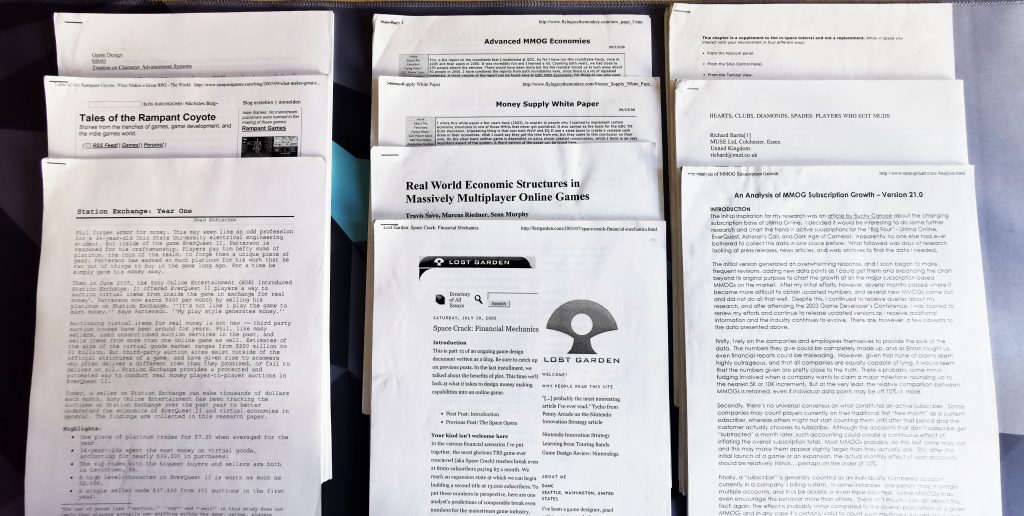In “Structuring my Field Notes“, I wrote:
“At the end of each section I will add a chapter that contains the titular fieldnotes. I went through my personal notebooks to gather my thoughts, lessons learned, and insights from the respective time period.”
I thought it might be interesting to talk about what personal notes I use to write these chapters and share some of them.
Notebooks, notebooks, and more notebooks
One source are indeed my old notebooks. These are the usual, black Moleskin-like notebooks you get everywhere. I use them to document my thoughts and learnings for over 20 years now. Oh, sure, I tried to replace them with something digital many times, but I never found a workflow that fits my personal style of note-taking. The closest I got is my digital Obsidian notebook.

Anyway, I have about two dozen or so notebooks from my time working on online games, virtual worlds, social media platforms, online and digital-physical experiences. I go through them one by one, and copy relevant bits into my Obsidian notebook by topic. Whenever I write a new chapter, I cross-reference these snippets to look for relevant insights, then integrate accordingly.
A huge pile of paper
The second source is literally a huge pile of paper. As some of you will remember the early Internet was expensive. Instead of reading while you paid being online by the minute (!), you downloaded your content to read it offline.
But also, early computers weren’t good reading devices – that’s why everybody had printers. And while I certainly didn’t keep everything, I still have a rather large library of papers, articles, and mailing list posts – the ones I found the most useful, usually with a lot of hand written comments on and around them.
The printouts are already sorted by topic, so when I write about something, I go through them and see if I can find something relevant. Then begins the hunt if I can still find the respective articles online. Sometimes the original sources, repositories, blogs, or websites are long gone,, which makes citing them in the book problematic.

There is also a large repository of text files on my hard drive. This contains a lot of old articles from way-back-when that I didn’t print, but still kept in digital form, as well as collections by others. Many of them also don’t have sources, and I did my best to hunt down where they came from.
A stack of bookmarks
Before using Obsidian, I kept my bookmarks in Pinboard.in. My Pinboard library also contains imported bookmarks from previous tools (Delicious, Posterous, Tumblr, ..), going back all the way to April 2006. Everything is tagged, and in many instances commented via the link summary.
I have them all imported into my Obsidian workspace and cross-link them to the topics as I write new chapters. While I won’t share my full Obsidian space, the Pinboard library is still online – with tags and everything.

A few abandoned blogs
Between 2009 and 2017 I maintained multiple blogs on different topics: One where I shared my own thoughts on game design, one for game and application programming, and one to talk about trends and inspiring things.
These blogs moved over time, from WordPress to Blogger to Tumblr to Medium. Eventually I grabbed their data and deleted them all (except one) because they were too much work to maintain & write for.
All the old articles were converted into Dublin Core notation and imported into Obsidian, which also took care of cross-referencing the tags.
Using them in the book is similar to the notebooks: Whenever I write a new chapter, I cross-reference the posts based on their tags & keyword searches. All relevant insights are then integrated into the chapter accordingly.

I am still thinking how I can share these publicly in a way that makes sense. Ideally it’s some kind of information repository, but since a lot of the information is old and obscure, I don’t want to put in a lot of work. Maybe at one point I will just add them to my public Obsidian notebook.
Other sources
A big source of inspiration are the interviews I’m doing for the book. Talking to these “eye witnesses” of the metaverse history helps me remember certain aspects, or learn new aspects I didn’t know about before. Usually the interviews are long discussions and conversations that are eventually condensed into a coherent interview. So, the original recordings might contain a lot more background that either goes into the fieldnotes, or the respective milestone chapters.
Then there are commercial books and academic papers. I have several metres of those in my book shelves and maybe more in my digital library. I am thinking about sharing the list / index of books & papers that are discussed & used in the book, similar to the endnotes.

And finally, there are many talks and presentations from conferences. Not just the big ones like the Game Developers Conference (which has a great vault where to view & download past talks), but also obscure and lesser known ones like Project Horseshoe or Lift Conference.
So, there are a lot of sources. And that’s also kind of the point: The fieldnotes chapters share my own personal perspective on the history, but the book should act as a metaverse sourcebook with lots of sources and links where to find other opinions and perspectives. My hope is that this will inspire others to publish and compare their own personal notes and opinions, overall leading to more nuanced discussions around the metaverse.
